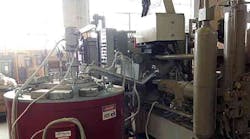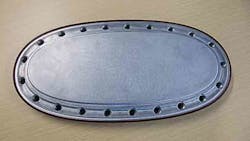The Lightweight Innovations for Tomorrow program aims to develop vacuum-aided diecasting technologies for aerospace, defense, and automotive applications, in a new initiative backed by The Boeing Co., among other manufacturers. Joining Boeing as the lead partner in the research is The Ohio State University College of Engineering, specifically the metalcasting program there.
“If we can reduce just a few ounces of metal from automobile engine mounting cradles or the housings that hold transmissions we can deliver an impact that is multiplied by the millions,” explained Larry Brown, executive director of LIFT. “In aerospace an added benefit might lower manufacturing costs as well as increase fuel savings from the lighter weight designs.”
LIFT — Lightweight Innovations for Tomorrow — is a “manufacturing innovation institute” operated by the American Lightweight Materials Manufacturing Innovation Institute, a partnership announced last year. Within the ALMMI partnership, the LIFT initiative is administered by the U.S. Navy Office of Naval Research.
Recently, LIFT announced a research program led by Grede Holdings LLC. Michigan Technological University to develop thin-wall iron castings for automotive transmission cases.
In standard, high-speed aluminum diecasting, microscopic bubbles of air may form within the molten metal during the mold-filling process. Part designers typically will accommodate the presence of such air voids by specifying thicker dimensions, involving more metal, to achieve the density and strength the finished part requires.
“We know in the laboratory that if we pull all the air out of the mold just before the molten metal flows in, we can eliminate the bubbles,” explained Alan Luo, professor of materials science and engineering and integrated systems engineering at The Ohio State University. “Without bubbles we can design thinner parts that are just as strong and durable, but with less metal and lighter weight.”
Luo, who also is the Foundry Educational Foundation Key Professor, added: “There are other benefits, as well, because the new process allows us to heat-treat parts after they are cast, which will improve their performance in service.”
The two-year project also will address computer modeling of aluminum diecasting performance by combining information about the material microstructure numerous design and production parameters. This integrated computational materials engineering (ICME) process may accelerate design and qualification for new components.
“If you can take a common part, such as an access panel you see on the wing of an airplane, and use high-integrity diecastings, it could reduce weight and manufacturing costs,” commented Boeing associate technical fellow Russ Cochran. “We hope to demonstrate that advances in high-vacuum diecasting will produce parts that meet all the rigorous performance specifications we require, while realizing weight and efficiency goals."
Also contributing to LIFT’s new project will be Alcoa, Eaton Corp., Comau, and Nemak, among the industrial partners; and Worcester Polytechnic Institute, Southwest Research Institute, the University of Michigan, and Massachusetts Institute for Technology as the research partners.
The American Foundry Society and North American Die Casting Association (NADCA) are involved to disseminate information on how to use the new materials and techniques emerging from the project in a manufacturing setting.
“What we are doing here is bridging that gap between great research in laboratories and great manufacturing skills in private industry,” according to Brown. “Once you bring these innovations into production, the results just multiply.”










